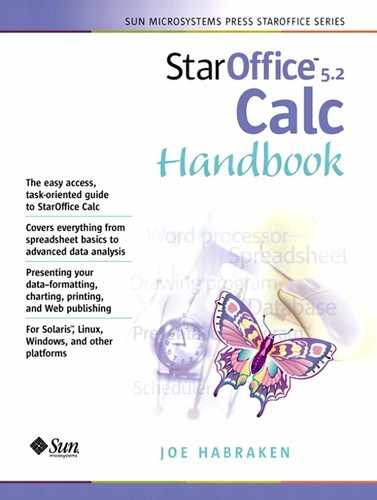Working with Font Attributes
While formatting numerical values is an important aspect of designing a spreadsheet, another way to emphasize certain entries on a spreadsheet and generally make the spreadsheet more readable is through the use of font attributes. Font attributes include the actual font style (such as Arial or CG Times), the size of the characters, and other character attributes like bold and underline (color is also a font attribute, but it is discussed in the section “Working with Colors, Borders, and Backgrounds”).
You can assign font attributes to cells holding text or values in your spreadsheets. One of the fastest ways to make changes to the font attributes of a cell or a selected range of cells is to use the font tools on the Object toolbar. Figure 3.5 provides a view of these font tools.
Figure 3.5. The Object toolbar provides font tools that make it easy to change font attributes.

For example, if you wish to change the font type for a range of selected cells, select the cells and then click the Font Name drop-down box and select a new font type (the “look” of each font on the drop-down list is provided). Selected cells will be formatted with the newly chosen font type.
You can also quickly change the font size using the Font Size drop-down box. Just select the cells. The default font size in Calc is 10 points (one inch contains 72 points). While this font size may look fine on your screen, you will probably find that it is a little on the small size when you print your spreadsheet out. The 12-point font size is considered the standard for printed spreadsheets and is roughly equivalent to the old 10-pitch type (used for business letters) that was available on a typewriter.
Using the Bold, Italics, and Underline tools on the Object bar is similar to the other font tools that we've discussed. Select the cells you wish to make bold, italics, or underline and then click the appropriate tool on the Object bar. Remember that these tools operate as “toggle switches.” Click the tool once to turn it on, click the tool again to turn it off.
Note
You will find that too much font formatting in a spreadsheet can be distracting. You may want to limit yourself to only one font type or two, and only use bold, italics, and colors when they truly enhance the spreadsheet.
You can also change the font attributes for a cell or selected cells using the Font tab of the Cell Attributes dialog box. This tab provides access to some font formatting options that are not available on the Object toolbar.
To Change the Font Attributes
1. |
Select the cell or cell range for which you wish to change the font attributes. |
2. |
Right-click the cell or cell range and select Format Cells from the context menu. The Cell Attributes dialog box appears. |
3. |
Select the Font tab on the dialog box (see Figure 3.6). Figure 3.6. The Font tab of the Cell Attributes dialog box provides access to different font attributes.
|
4. |
To select a different font type, use the Font scroll box. |
5. |
To change the font style (such as bold, italics, or both) use the Style scroll box. |
6. |
To change the size of the font, use the Size scroll box. |
The Preview area shows you how the changes you make on the Font type will affect the data in the cell or cell range you are formatting. You will also find that special font effects are listed as checkboxes in the Effects box on the Font tab. These effects provide you with additional options for drawing attention to certain areas of the spreadsheet. The special effects are:
Outline— This effect only shows the contour of the characters in the cell or range of cells (the effectiveness of this effect will vary from font to font).
Shadow— Places a shadow between data characters in the cell.
Underline— Underlines the characters and spaces in the cell or range of cells.
Strikethrough— Places a line through the characters in the cell or range of cells.
Once you have made your font-related selections on the Font tab, you can click OK to close the Cell Attributes dialog box. This returns you to the spreadsheet and your font changes will appear on the active cell or selected range.
You can also access font attributes for the characters in a particular cell when you are in the editing mode in the cell. For instance, to change the font attributes for one selected word or character string in a cell that you are working in, you can select the item and then right-click on the selection. The context menu that appears provides access to Font, Size, and Style choices that provide submenus of choices (which include all the different style options we've discussed such as bold, underline, shadow, and so on.)
If you wish to open a separate Font dialog box for the selected text or character string, click Character on the context menu. Figure 3.7 shows the Font dialog box. It contains the same choices as the Font tab of the Cell Attributes dialog box, but can be used to change the font attributes of individual characters or character strings within a cell (rather than the font attributes of all the data in a particular cell, which is handled by the Font tab on the Cell Attributes dialog box).
Figure 3.7. The Font dialog box provides access to character attributes for selected text and other characters within a cell.

Once you have made your selections in this dialog box, click OK to return to the spreadsheet. Remember that only the text or characters selected within the cell will have their attributes changed using this particular dialog box.

